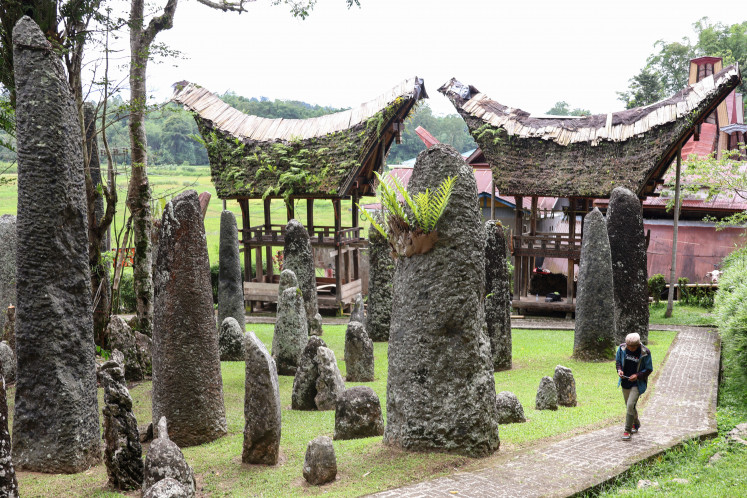Popular Reads
Top Results
Can't find what you're looking for?
View all search resultsPopular Reads
Top Results
Can't find what you're looking for?
View all search resultsExpeditionary force for Indonesian defense
Furthermore, a deeper look at TNI’s expeditionary assets (The Military Balance, 2016) reveals a concerning shortcoming that could strain operations. Quantitatively, the naval, army and air force transportation assets are limited in being able to support operations in multiple theaters along the country’s border.
Change text size
Gift Premium Articles
to Anyone
M
ost recent discussions of regional security in Southeast Asia center on the ongoing tension in the South China Sea. China’s apparent assertiveness in expressing its claim to this region has raised concerns with Southeast Asian countries bordering this strategic spot.
Indonesia, which controls the Natuna Islands in the southern end of the sea, keeps its distance from the dispute and tries to serve as an honest broker to keep the area peaceful and secure.
But recent events seem to have prompted Indonesia to increase its defensive posture in the region. Several Chinese fishing boats — backed by armed coast guard vessels — have encroached into Natuna waters, and clashed with Indonesian security and military boats. In response, President Joko “Jokowi” Widodo inaugurated an expansion of Natuna’s airbase at the Indonesian Military (TNI) anniversary event last month.
Thanks to the improvements, Natuna can now host a larger contingent of military forces when security tension escalates. Such forces may include soldiers and marines, with support from naval ships, aircraft and helicopters, to patrol the islands and its surrounding battle space.
Despite building the infrastructure, a question remains. At the strategic level, what would be required of TNI to respond to challenges given the country’s geographical contour, especially at its door-step, such as in Natuna, Nunukan and Morotai?
Expanding on the notion of archipelagic defense (Krepinevich, 2015), TNI could utilize Indonesia’s unique geography in developing the strategy. It primarily thrusts its deterrence through denial, where the adversary’s intention to control or occupy a maritime region through force is denied by an interlocking and mutually reinforcing chain of air, sea and ground forces.
Utilizing this concept, TNI could deploy its tri-service assets along the string of islands in the archipelago. These combined sea, air and ground operations would entail deployment of surveillance, patrol and strike forces, as well as transportation assets that would sustain the operations.
Using the Natuna Islands as an example, the army and marine elements would defend the island from an amphibious assault force and man artillery and missile batteries to harass an approaching naval fleet. The navy ships would conduct patrols against surface combatants and submarine intrusions. Aircraft would comb the horizon for any incoming force and would deny any attempt at air supremacy in the area.
The ships and planes could be based in either Pontianak or Batam, where there is more support capability for naval and air operations. In turn, these two bases would be supported by reinforcement from the main bases in Java or Sumatra.
Such patterns could be replicated for securing the Strait of Makassar from Nunukan and Tarakan, and similarly for the defense of the Moluccas from the hub in Morotai.
These interlocking forces in the islands, though, are just one of the necessary pillars to successfully implement the archipelagic defense. The other essential pillar for this to be effective is the military capability — also known as expeditionary capability — to move and sustain those combat forces, especially for soldiers on the ground in those outermost islands.
As such, it is as critical to assess the Indonesian military’s expeditionary capability as to measure its more menacing combat forces. This would be through examining TNI’s organizational posture, as well as the primary assets — transport vessels, aircraft and helicopters — in fulfilling such capability.
Although all military operations are directed from the TNI headquarters as joint operations by utilizing various forces from the three services, seamless tri-service combined operations could be very challenging due to a lack of regular joint training among TNI’s units.
The challenge is especially compounded for the expeditionary units as their training regimen mostly depends on all-arms exercises rather than specific exercises for them.
A robust and sustainable train of reinforcement and logistics is essential for the archipelagic defense to be effective.
Furthermore, a deeper look at TNI’s expeditionary assets (The Military Balance, 2016) reveals a concerning shortcoming that could strain operations. Quantitatively, the naval, army and air force transportation assets are limited in being able to support operations in multiple theaters along the country’s border. Moreover, the assets are subject to constraints such as the lack of maintenance and limited supply and crew capability, which reduce operations.
The naval amphibious vessels are the primary means for TNI’s expeditionary force. From these ships, marines assault beaches and sustain them for the fight. They also maintain logistical train to reinforce and resupply the troops on the ground. The bigger ships also can launch helicopters for expanding the marine’s operational area.
Currently, if using all its ships at one time, the Indonesian navy can deliver about one-and-a-half marine or army brigades with their associated tanks and artillery.
Considering operational cycles, the most that the ships can transport at any one time is around one brigade of 2,000 troops.
As this capacity must be divided to allow for support of at least three outposts in the sprawling archipelago, the navy could move only about a battalion to a theater. That is indeed only a limited reinforcement for the island defenders.
From the air, the mainstay of TNI’s airlift is provided by 15 Hercules medium transport aircraft. They can drop paratroopers from their bases in Java into the outposts even with only a rough landing strip.
When all of them are operational, a brigade of paratroopers can be delivered to a location. Due to operational constraints, though, only about a battalion of 600 troops can be transported at one time to a location, which is, again, a limited transportation capacity.
Another critical airlift and logistical asset is the helicopter fleet, which can be stationed in forward bases –such as Pontianak – for reinforcement of logistical sustenance of troops in the outpost. The air force depends on Super Puma for this purpose, and the army utilizes the Russian-made Hip helicopter. Both are of the medium-lift type.
Their limited lift capacity and operational endurance, however, hamper the necessary reach to maintain the interlocking quality of archipelagic defense. For this critical purpose, TNI needs heavy-lift helicopters with greater payload and range capability.
Moreover, as these helicopter fleets would be the main artery in this strategy, their operational readiness must be at the highest level, which can be obtained through extensive crew training, proper maintenance and reliable supply of parts. Our soldiers and marines depend on this logistical train as provided by the expeditionary force. They are the critical link in erecting Indonesia’s archipelagic defense chain. We need those ships, aircraft and helicopters now.
***
The writers are political scientists and public affairs consultants at Kiroyan Partners. The views expressed are their own.
---------------
We are looking for information, opinions, and in-depth analysis from experts or scholars in a variety of fields. We choose articles based on facts or opinions about general news, as well as quality analysis and commentary about Indonesia or international events. Send your piece to community@jakpost.com.










